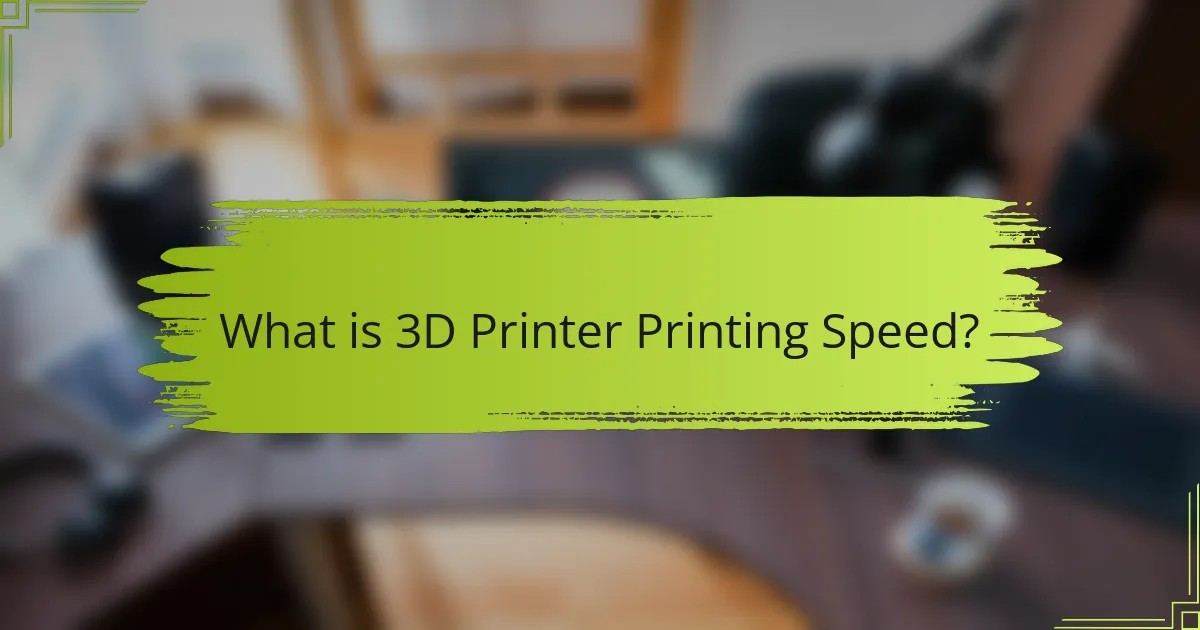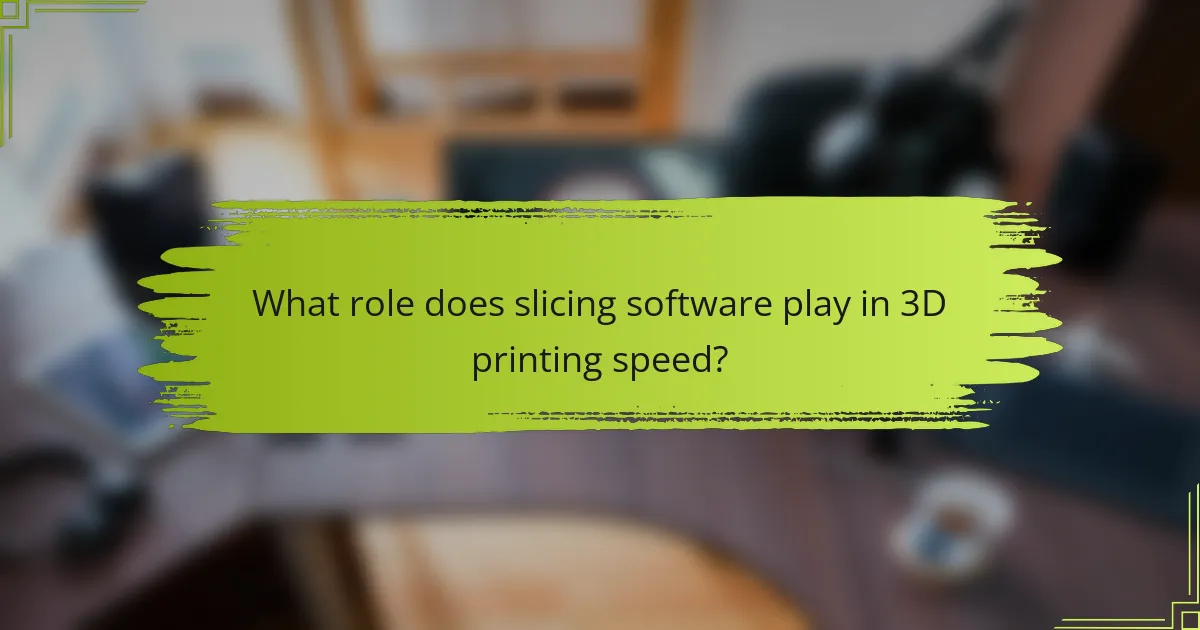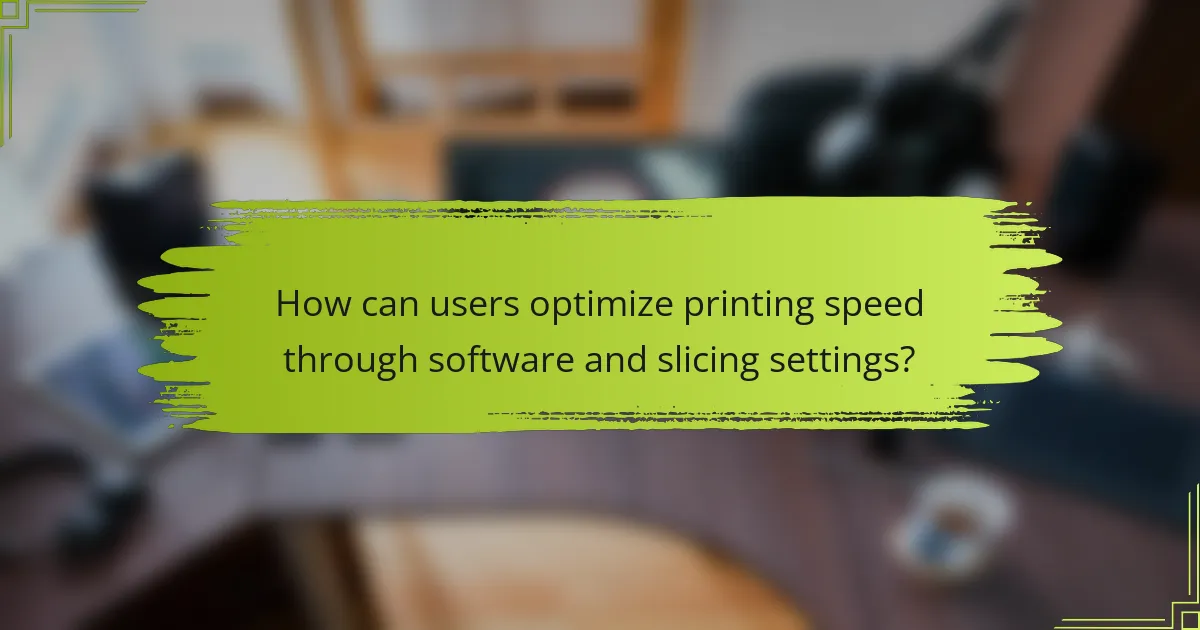
What is 3D Printer Printing Speed?
3D printer printing speed refers to the rate at which a 3D printer can produce an object. This speed is typically measured in millimeters per second (mm/s). Different 3D printers have varying speeds based on their technology and design. For example, FDM printers often operate between 30 to 300 mm/s. SLA printers, on the other hand, may have different metrics based on layer curing times. The printing speed can significantly affect the overall print time and quality. Faster speeds can lead to lower resolution and detail, while slower speeds may enhance precision. Various factors, including material type and print settings, influence the optimal speed for a specific print job.
How is printing speed measured in 3D printers?
Printing speed in 3D printers is typically measured in millimeters per second (mm/s). This metric indicates how fast the printer’s print head moves during the printing process. Higher speeds can reduce print time but may affect print quality. Most consumer 3D printers have a speed range of 30 to 300 mm/s. Print speed can vary based on the type of material and the complexity of the model being printed. Additionally, slicing software often allows users to adjust the speed settings for different layers or features of a print. This flexibility helps optimize both speed and quality for specific printing tasks.
What units are used to quantify 3D printing speed?
The units used to quantify 3D printing speed are typically millimeters per second (mm/s). This measurement indicates how fast the printer’s nozzle moves while extruding material. Speed can also be expressed in cubic millimeters per second (mm³/s) to account for the volume of material being deposited. Both units provide insights into the efficiency and performance of a 3D printer during operation.
How do different printer types affect speed measurements?
Different printer types significantly affect speed measurements. FDM printers generally have lower speeds compared to SLA printers. For example, FDM printers often operate between 30 to 150 mm/s. In contrast, SLA printers can achieve speeds of 100 mm/h to 300 mm/h. Speed measurements also vary with printer settings and materials used. High-speed settings may compromise print quality in FDM printers. SLA printers typically maintain quality while achieving faster print speeds. Additionally, the complexity of the print design influences speed across all printer types. Overall, the type of 3D printer directly impacts speed performance and efficiency.
Why is printing speed important in 3D printing?
Printing speed is important in 3D printing because it directly affects production efficiency. Faster printing reduces the time required to create parts. This leads to increased throughput in manufacturing environments. High printing speeds can also lower operational costs by minimizing machine run time. However, excessive speed may compromise print quality and detail. Balancing speed and quality is crucial for optimal results. Studies show that printing speed can impact layer adhesion and surface finish. Therefore, understanding the relationship between speed and print quality is essential for effective 3D printing.
What impact does speed have on print quality?
Speed directly influences print quality in 3D printing. Higher printing speeds can lead to reduced detail and accuracy. This occurs because the extruder may not have enough time to deposit material evenly. As a result, layers may not bond properly, causing defects. Conversely, slower speeds allow for better material flow and adhesion. Research indicates that optimal speeds balance quality and efficiency. For example, a study by Huang et al. (2020) found that speeds above 60 mm/s significantly decreased layer adhesion strength. Thus, speed is a critical factor in achieving desired print quality.
How does speed influence production time and costs?
Speed directly influences production time and costs in 3D printing. Higher printing speeds reduce the time required to complete a project. This decrease in production time can lead to lower labor costs and faster turnaround for clients. However, increased speed may affect print quality, leading to potential reprints and additional costs. Research indicates that optimizing speed without sacrificing quality can enhance efficiency. For example, a study by P. Duflou et al. in “Additive Manufacturing” highlights that balancing speed and quality is crucial for cost-effective production. Thus, speed impacts both the duration of the printing process and the overall expenses involved.

What role does slicing software play in 3D printing speed?
Slicing software significantly influences 3D printing speed by converting 3D models into instructions for printers. It determines layer height, print speed, and infill density. These parameters directly affect how quickly a printer can produce a part. For instance, a lower layer height results in finer detail but increases print time. Conversely, a higher layer height speeds up the process but may compromise quality. Additionally, slicing software optimizes tool paths, minimizing unnecessary movements. Efficient tool path management can reduce overall printing time. Studies show that optimized slicing settings can improve print speed by up to 50%. Thus, the role of slicing software is crucial in balancing speed and quality in 3D printing.
How does slicing software affect the printing process?
Slicing software directly influences the 3D printing process by converting 3D models into instructions for printers. This software determines layer height, print speed, and infill density. Each of these factors affects the final print quality and time taken. For example, a lower layer height results in finer details but increases print time. Conversely, a higher layer height speeds up printing but may reduce detail. Additionally, slicing software optimizes the path the printer head takes, affecting efficiency. Studies show that different slicing settings can lead to significant variations in print speed and quality outcomes.
What are the key features of slicing software that influence speed?
Key features of slicing software that influence speed include layer height, infill density, and print speed settings. Layer height determines the thickness of each printed layer. A smaller layer height results in more layers, increasing print time. Infill density affects how solid the print is. Higher infill density requires more material and time. Print speed settings specify how fast the printer moves while extruding filament. Faster speeds can reduce print quality. Additionally, support structures can add time if they are needed. The complexity of the model also impacts slicing time. More intricate designs require additional processing, which can slow down the overall printing speed.
How do different slicing settings impact printing speed?
Different slicing settings significantly impact printing speed. Lower layer heights increase detail but slow down the process. Higher layer heights reduce print time but may compromise quality. Print speed settings directly influence how fast the printer moves. A faster print speed can lead to less precision. Infill density affects the amount of material used, impacting both speed and strength. Fewer support structures can also enhance speed by reducing the time spent on unnecessary prints. Adjusting these settings allows users to find a balance between speed and quality based on project requirements.
Why is it essential to choose the right slicing software?
Choosing the right slicing software is essential for optimizing 3D printing performance. Slicing software translates 3D models into instructions for printers. The quality of these instructions directly affects print speed, accuracy, and material usage. High-quality slicing software can enhance layer adhesion and reduce print failures. It can also provide advanced settings for better customization. For instance, certain software options allow for variable layer heights, improving print efficiency. Additionally, the right software can support various file formats and printer types, ensuring compatibility. Overall, selecting appropriate slicing software is crucial for achieving desired printing outcomes.
What are the most popular slicing software options available?
The most popular slicing software options available include Cura, PrusaSlicer, and Simplify3D. Cura, developed by Ultimaker, is widely used due to its user-friendly interface and extensive feature set. PrusaSlicer, created by Prusa Research, offers advanced features and is optimized for Prusa printers. Simplify3D is a premium option known for its powerful capabilities and customization options. Each of these software solutions supports various 3D printer models and provides settings that can significantly affect printing speed and quality.
How do user preferences shape software selection for speed optimization?
User preferences significantly influence software selection for speed optimization in 3D printing. Users often prioritize software that provides faster slicing times and efficient print management. Preferences for user-friendly interfaces also affect the choice of software, as ease of use can lead to quicker setup and adjustments. Additionally, users may favor software with advanced features like adaptive slicing, which can optimize speed based on model complexity. Research indicates that software that integrates seamlessly with various printers is often preferred, as it reduces downtime and enhances overall printing speed. Ultimately, user feedback and requirements directly shape the development and improvement of software aimed at optimizing 3D printing speeds.

How can users optimize printing speed through software and slicing settings?
Users can optimize printing speed through software and slicing settings by adjusting several key parameters. Reducing layer height can decrease print time but may affect quality. Increasing print speed settings in the slicer directly enhances speed. Using a larger nozzle size allows for faster extrusion rates. Disabling unnecessary features like supports or infill can also save time. Additionally, optimizing travel speed minimizes non-printing movements. Setting acceleration and jerk values appropriately can enhance responsiveness. Finally, utilizing adaptive slicing techniques can adjust layer height dynamically, balancing speed and quality.
What best practices can enhance 3D printing speed?
To enhance 3D printing speed, users should optimize print settings and choose appropriate materials. Adjusting layer height to a thicker setting can significantly reduce print time. Increasing print speed settings, while maintaining quality, also contributes to faster results. Utilizing a larger nozzle diameter allows for more filament flow, speeding up the process.
Additionally, minimizing the number of supports and optimizing the model orientation can decrease print time. Employing advanced slicing software can further enhance speed by efficiently generating toolpaths. Research indicates that optimizing these factors can lead to a reduction in print times by up to 50% in some cases.
How can adjusting layer height improve speed without sacrificing quality?
Adjusting layer height can improve printing speed without sacrificing quality by optimizing the amount of material deposited. Thicker layers reduce the total number of layers needed for a print. This leads to faster print times since the printer spends less time moving between layers.
For instance, a layer height of 0.2 mm may print faster than 0.1 mm while still maintaining acceptable detail. Many 3D printers can produce high-quality prints with layer heights up to 0.3 mm, depending on the model and material used.
Research indicates that the optimal layer height can vary based on the complexity of the model. A study by D. W. H. S. et al. in “Additive Manufacturing” found that adjusting layer heights can significantly impact print speed while maintaining dimensional accuracy.
What slicing strategies can minimize print time effectively?
Using adaptive layer height can minimize print time effectively. This strategy allows for varying layer thickness throughout the print. Thicker layers can be used for less detailed areas. Thinner layers are reserved for intricate details. This balance reduces overall print time without sacrificing quality. Additionally, optimizing infill patterns can decrease material usage and speed. For example, using a grid or triangular pattern often prints faster than a solid fill. Another strategy is to adjust print speed settings based on complexity. Slower speeds may be necessary for detailed sections, while faster speeds can be used for simpler areas. Reducing the number of supports also contributes to shorter print times. Using support structures only where absolutely necessary can streamline the process. These strategies, when combined, can significantly enhance efficiency in 3D printing.
What common troubleshooting tips exist for improving printing speed?
To improve printing speed, adjust the print settings in the slicing software. Lowering the layer height can increase speed without sacrificing quality. Increasing print speed settings in the slicer can also enhance overall performance. Use a larger nozzle size to extrude more filament at once. Ensure the printer’s firmware is updated for optimal performance. Regularly maintain and clean the printer to prevent slowdowns caused by mechanical issues. Additionally, optimize the model’s design by reducing unnecessary supports and infill. These strategies can significantly enhance 3D printing efficiency.
How can users identify and resolve speed-related issues in their prints?
Users can identify speed-related issues in their prints by analyzing print settings and observing print quality. Checking the layer height is essential, as larger heights can reduce print time but may affect detail. Users should also examine the print speed settings in the slicing software. A speed that is too high can lead to poor adhesion and layer misalignment.
Monitoring the printer’s movement can reveal if it is moving slower than expected due to mechanical issues. Additionally, users should inspect the filament feed. A clogged nozzle can hinder material flow, resulting in slower prints.
To resolve these issues, users can adjust the print speed settings to a more optimal level. Reducing the layer height can improve detail while maintaining speed. Regular maintenance, such as cleaning the nozzle and ensuring smooth movement of the printer’s axes, can also enhance print speed.
These actions can lead to improved print quality and speed, ensuring a more efficient printing process.
What adjustments can be made to hardware to support faster printing speeds?
Upgrading hardware components can significantly enhance printing speeds. Increasing the stepper motor current allows for quicker movement of the print head. Installing a high-speed extruder reduces the time taken to melt and deposit filament. Utilizing a larger nozzle diameter enables faster material flow during printing. Implementing a heated print bed minimizes warping and allows for quicker adhesion of prints. Enhancing the frame rigidity decreases vibrations, which can lead to faster and more accurate prints. Upgrading to a faster motherboard improves communication between components, reducing latency. Finally, using high-performance cooling fans can allow for faster layer cooling, enabling quicker layer transitions. These adjustments collectively contribute to improved 3D printing speeds.
3D printer printing speed is a critical metric that determines how quickly a 3D printer can produce objects, typically measured in millimeters per second (mm/s). This article analyzes the impact of various printer types, slicing software, and settings on printing speed, highlighting the trade-offs between speed and print quality. Key factors influencing speed include layer height, print speed settings, and infill density, which can be optimized through effective slicing software. Additionally, the article discusses best practices for enhancing speed while maintaining print quality, as well as common troubleshooting tips and hardware adjustments to support faster printing speeds.